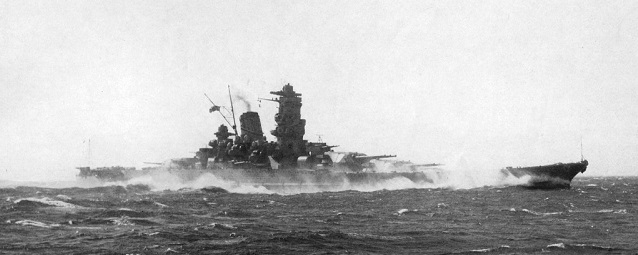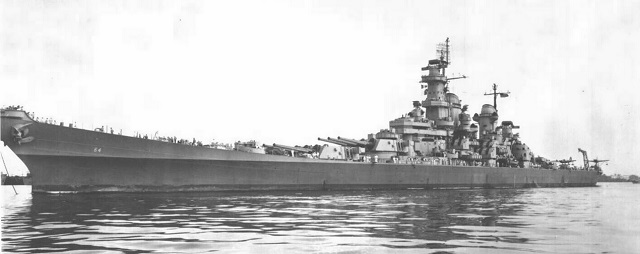December 22, 2013


After doing research, racking my brain, and a lot of staring at the ceiling, I simply could not come up with a way that the Yamato had a legitimate chance to win, short of stupidly restrictive rules. Limiting the area of combat to 20 miles or whatever, for example. Without doing that, there just doesn't seem to be a way that the Iowa could lose, save for luck.
The Japanese ship's main (only?) advantage is her 18.1" guns' longer range. The Type 94 had a range of 26 miles, while the American 16"/50 Mk 7 could throw a shell (essentially) 24 miles. Penetration ability for the two was found to be roughly the same. But at all ranges, the US gun was more accurate.
So unless the Yamato could put an unlikely round on target in that two mile stretch where the Iowa couldn't respond, almost everything pointed toward the technically smaller ship's advantage. She was faster by at least six knots, her armor layout was better, the fire control was much better, even the secondary battery would better. Other than sheer size and an amazing amount of built-in buoyancy (a Yamato-class ship was designed to have every compartment outside of her armored box area ["A" turret to "X" turret"] flooded and still float), the Japanese ship had one other thing going her way: the only impenetrable armor ever put to sea.
The armor on the front of the three main gun turrets on the Yamato was 26" thick, sloped at 45°. In US Navy testing after the war, this armor could be penetrated only when an Iowa's gun was placed at 0° inclination to the armor plate, and at a range of zero yards... in other words, a completely unrealistic situation in battle. In any likely combat situation, there was no way to punch through the armor on the front of a Yamato's main turret.
So, one advantage, I suppose, but not one to hang a battle on. The only way the chances of victory for the Japanese begins to become realistic is if they can close the range, so to counteract the huge fire control advantage the American ship has. If that happened, then you're looking at a coinflip, maybe even a Japanese advantage as their superior weight of broadside plummets down. But with their six knot speed advantage, the Americans can decide the range and keep it there.
So, good idea for a post, but it kinda doesn't work. It happens. A better battle might be Yamato vs South Dakota, since a SoDak is, for all intents and purposes, a slower Iowa. Maybe in the future.
Posted by: Wonderduck at
10:17 AM
| Comments (19)
| Add Comment
Post contains 495 words, total size 4 kb.
One of Dunnigan's books (I think it was "Dirty Little Secrets of WWII") has exactly this analysis, considering a hypothetical battle between four Iowas and four Yamatos. He comes to the same conclusion: the Yamatos get creamed.
Even at range the Iowas have the advantage, because they can fire twice as fast, and because they had radar targeting. The Yamato's armor belt turns out to be less impressive than it should be, because it was made with inferior steel and mounted badly. The Iowa's armor belt wasn't as thick but it was better made.
The biggest differences were speed (Iowa was 4 knots faster according to Dunnigan), gunnery (Iowa could fire twice as fast) and targeting (the Iowa had radar) and though there's always luck in battle, the Iowas had a significant edge.
It almost happened! Iowa and Yamato were both involved in the Leyte Gulf operation, and except for Halsey chasing a decoy, they might have met!
Posted by: Steven Den Beste at December 22, 2013 12:37 PM (+rSRq)
Posted by: Steven Den Beste at December 22, 2013 12:40 PM (+rSRq)
Posted by: Steven Den Beste at December 22, 2013 01:09 PM (+rSRq)
She never did fire her guns in anger at a surface target.
Posted by: Wonderduck at December 22, 2013 01:15 PM (Izt1u)
The Yamato certainly did fire her main guns in combat! She was part of Kurita's Center Force during the Battle Off Samar, the group that stumbled into Taffy-3. Yamato put 18" holes into the Gambier Bay and put at least one and possibly more 18" rounds into the Hoel.
Posted by: Wonderduck at December 22, 2013 01:23 PM (Izt1u)
The ironic thing was the armor mounted on the IOWA-class was not all that good according to the standards of the day. Class 'A' and 'B' armor plate used by the US Navy were inferior to some of their foreign counterparts (Though contrary to what some people believe, not the Japanese.), which the US Navy apparently did not realize until just before WW2, by which time it was too late. The need for production during the war precluded the introduction of much better armor. It still does not justify the rubbishing of the IOWAs by certain folks at Avalanche Press and the late David Brown, to mention a few.
Not that the Japanese were any better. The standard armor used for the Yamato-class was a slightly improved version of the Vickers armor the Japanese obtained during WWI. The Japanese made it easier to make the armor from domestic resources (Something which some nations - most notably Germany, fail to do so.), but the level of protection was only marginally improved. They DID develop significantly better armor, but none of it saw production or service.
Posted by: cxt217 at December 22, 2013 04:39 PM (l1UEN)
Posted by: Mauser at December 22, 2013 06:37 PM (TJ7ih)
Would they sink her? No, probably not, but trashing her topsides is just as effective. "Mission kill" as opposed to "kill kill." Repairing an Iowa these days would a nightmare, come to think of it...
Posted by: Wonderduck at December 22, 2013 07:23 PM (Izt1u)
Posted by: Mauser at December 22, 2013 08:30 PM (TJ7ih)
Posted by: cxt217 at December 22, 2013 10:54 PM (l1UEN)
Posted by: The Brickmuppet at December 23, 2013 11:04 AM (DnAJl)
I have to see that study myself and while the standard AP round for the SoDaks were 2200 lb sluggers, the IOWAs' standard AP round was the heavyweight 2700 lb. Both classes could and did fire the differently sized AP rounds from what they were designed for, but they used different standard AP rounds.
C.T.
Posted by: cxt217 at December 23, 2013 02:59 PM (N3TvP)
As it turns out, it's "Victory at Sea" by Dunnigan and Nofi. I started re-reading it last night and stumbled across the article.
Posted by: Wonderduck at December 23, 2013 08:57 PM (Izt1u)
Posted by: muon at December 25, 2013 04:28 AM (jFJid)
Posted by: Wonderduck at December 25, 2013 06:57 AM (Izt1u)
Posted by: Suburbanbanshee at December 26, 2013 10:22 PM (cvXSV)
Posted by: diamond dave at January 06, 2014 02:30 PM (MK+sE)
Dave, when Dunnigan did his analysis, he stipulated that he was considering an action between 4 Yamatos and 4 Iowas, precisely to reduce the luck factor. One ship might get crippled by a lucky hit, but it isn't going to happen four times. The battle would be decided by the fighting characteristics of the ships, which is what he was looking at in his analysis.
And he concluded that the Iowa's would win.
Posted by: Steven Den Beste at January 06, 2014 06:37 PM (+rSRq)
But the Yamato could very easily score crippling hits on Iowa's engines or boilers via short rounds that penetrate under the waterline and thus negate her speed/maneuver advantage.
Given that there is only one confirmed case in the Pacific War where a Type 91 diving round actually worked as the Japanese intended it to, this would truly be a Golden BB shot (All the more so given the tight patterns the Japanese used for their shots.). We have not even gotten to how fast the IOWA could run on three screws or down one boiler room - unlike many British designs, knocking out one boiler or engine room was highly unlikely to take out another engine room or boiler.
Such hits would decide the battle essentially at once, but you can not really count on them occurring when you need them.
Ob: Brickmuppet's point - I looked up the stats and you are correct that the 16"/45 mounted by the SoDaks had better deck penetration than the 16"/50 mounted by the IOWAs while firing the same 2700 lb AP round. But the performance was generally small, and the 16"/50 were rated at longer ranges than the 16"/45.
Posted by: cxt217 at January 07, 2014 08:59 PM (sEA0S)
46 queries taking 0.2052 seconds, 180 records returned.
Powered by Minx 1.1.6c-pink.









